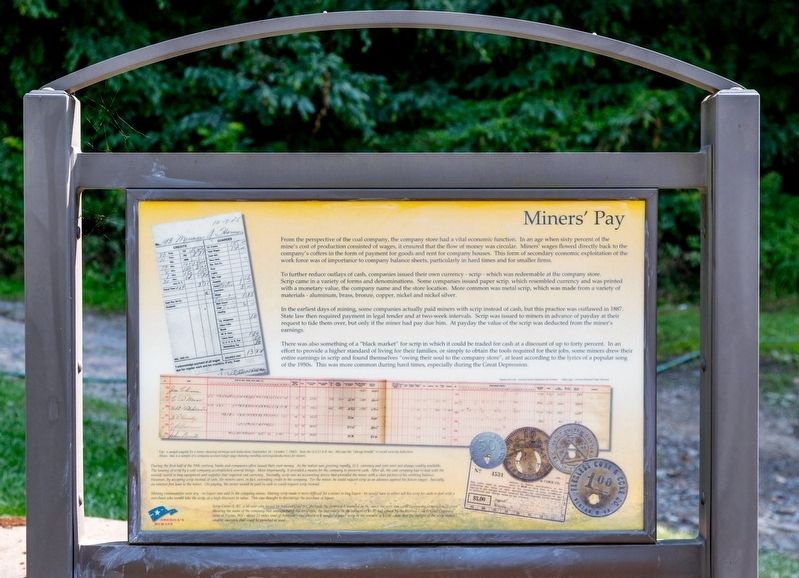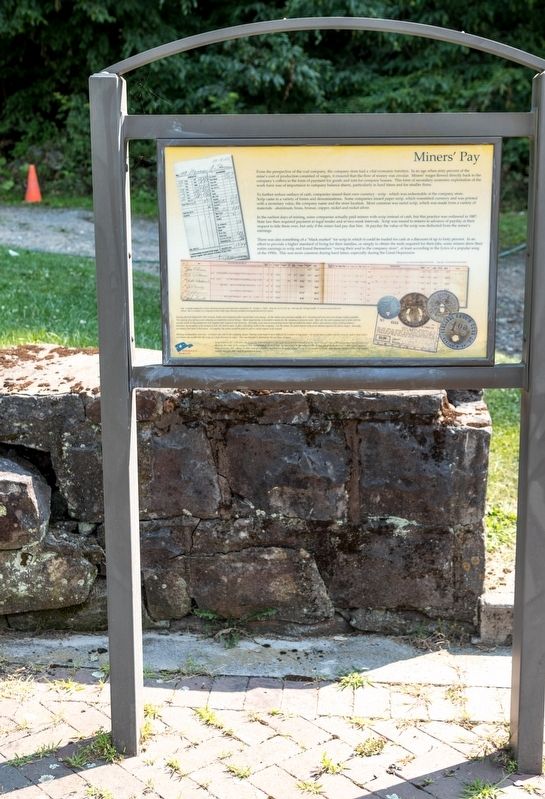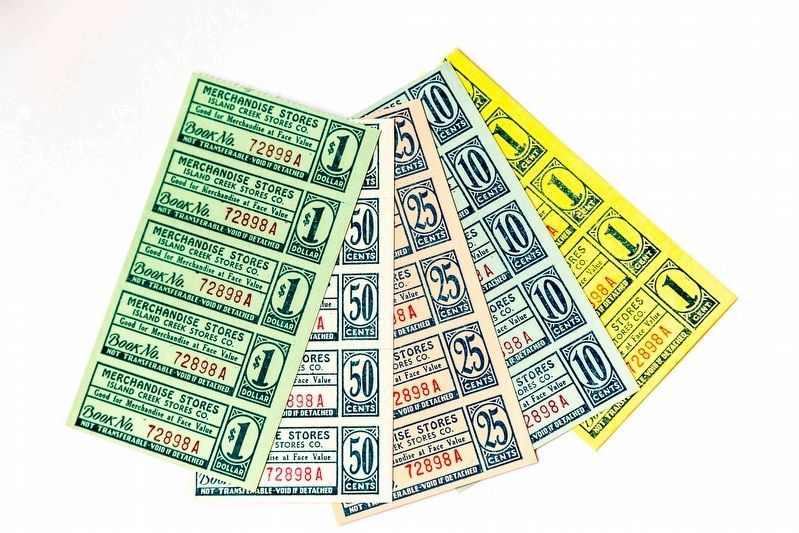Ashland in McDowell County, West Virginia — The American South (Appalachia)
Miners’ Pay
— National Coal Heritage Trail —
To further reduce outlays of cash, companies issued their own currency — scrip — which was redeemable at the company store. Scrip came in a variety of forms and denominations. Some companies issued paper scrip, which resembled currency and was printed with a monetary value, the company name and the store location. More common was metal scrip, which was made from a variety of materials — aluminum, brass, bronze, copper, nickel and nickel silver.
In the earliest days of mining, some companies actually paid miners with scrip instead of cash, but this practice was outlawed in 1887. State law then required payment in legal tender and at two-week intervals. Scrip was issued to miners in advance of payday at their request to tide them over, but only if the miner had pay due him. At payday the value of the scrip was deducted from the miner's earnings.
There was also something of a "black market" for scrip in which it could be traded for cash at a discount of up to forty percent. In an effort to provide a higher standard of living for their families, or simply to obtain the tools required for their jobs, some miners drew their entire earnings in scrip and found themselves “owing their soul to the company store,” at least according to the lyrics of a popular song of the 1950s. This was more common during hard times, especially during the Great Depression.
(sidebar)
During the first half of the 19th century, banks and companies often issued their own money. As the nation was growing rapidly, U.S. currency and coin were not always readily available. The issuing of scrip by a coal company accomplished several things. Most importantly. It provided a means for the company to preserve cash. After all, the coal company had to deal with the outside world to buy equipment and supplies that required real currency. Secondly, scrip was an accounting device that provided the miner with a clear picture of his working balance. However, by accepting scrip instead of cash, the miners were, in fact, extending credit to the company. For the miner, he could request scrip as an advance against his future wages — basically, an interest free loan to the miner. On payday, the miner would be paid in cash or could request scrip instead.
Mining communities were dry — no liquor was sold in the company stores. Having scrip made it more difficult for a miner to buy liquor — he would have to either cell his scrip for cash or deal with a merchant who would take the scrip, at a high discount in value. This was thought to discourage the purchase of liquor.
Erected by National Coal Highway Authority and America’s Byways.
Topics. This historical marker is listed in these topic lists: Industry & Commerce • Natural Resources. A significant historical year for this entry is 1887.
Location. 37° 24.528′ N, 81° 21.223′ W. Marker is in Ashland, West Virginia, in McDowell County. Marker is on Cherokee Road (County Route 17) 5.8 miles east of Coal Heritage Road in Northfork, on the right when traveling east. Touch for map. Marker is in this post office area: Northfork WV 24868, United States of America. Touch for directions.
Other nearby markers. At least 8 other markers are within 7 miles of this marker, measured as the crow flies. No Work Tomorrow (a few steps from this marker); Young Miners (a few steps from this marker); Ashland Coal and Coke (a few steps from this marker); The Company Store (a few steps from this marker); Elizabeth Simpson Drewry (approx. 4.6 miles away); Bramwell (approx. 6.1 miles away); Mill Creek Coal & Coke Co.
(approx. 6.1 miles away); The Coal Barons (approx. 6.2 miles away). Touch for a list and map of all markers in Ashland.
More about this marker. This interpretive panel has a number of illustrations captioned as follows, top to bottom:
- sample payslip fir a miner showing earnings and deductions (September 24 October, 1945). Note the U.S.O.A.B. tax — this was the "old age benefit" or social security deduction.
- this is a sample of a company account ledger page showing monthly earnings/deductions for miners.
- a 50 cent coin issued by Ashland Coal & Coke (note the inverted A stamped on the coin)
- the next two coins display the reverse side of coins showing the name of the company that manufactured the scrip coin
- the last coin in the amount of $1.00 and issued by the Peerless Coal & Coke Company mine at Vivian, WV — about 12 miles west of Ashland.
- a sample paper scrip in the amount of $3.00 — note that the margin of the scrip shows smaller amounts that could be punched as used.
Also see . . . Sixteen Tons by Merle Travis sung by Ernie Ford. “I sold my soul to the company store”
Credits. This page was last revised on August 14, 2021. It was originally submitted on August 6, 2021, by J. J. Prats of Powell, Ohio. This page has been viewed 180 times since then and 25 times this year. Photos: 1, 2, 3, 4. submitted on August 6, 2021, by J. J. Prats of Powell, Ohio.


